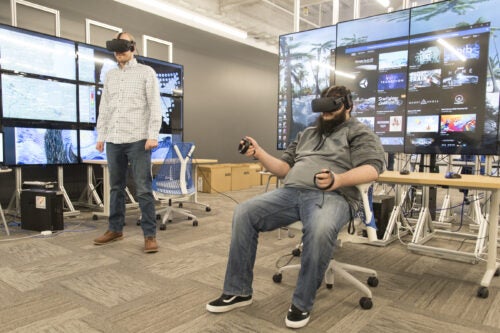
Boise State University students now have a unique opportunity to work in the field of virtual reality (VR). The university’s Department of Computer Science recently was awarded 10 virtual reality headsets designed by Oculus VR and asked to join the Oculus NextGen VR Research University program, an educational virtual reality program with select partner universities across the nation.
“We intend to use the rifts for architectural, immersive experiments, art and anything else we can get students to try out,” said Steve Cutchin, associate professor of computer science and director of research computing. Cutchin is actively recruiting students interested in the field of virtual reality to help develop Boise State’s program.
The aim of the Oculus NextGen research program is to help universities develop their virtual reality education programs, as well as use virtual reality in novel ways, for instance, as architectural aids or for career training. As a partner university, Boise State receives educational support from Oculus and participation in the Oculus NexGen Workshop.
Cutchin currently is looking for students with some experience in programming or computer science to work on new projects with the Oculus Rift headsets.
“The goal is to find people with the time and the interest to do something creative with virtual reality,” Cutchin said. “What I’m looking for is excitement, people who want to come in, hang out and make stuff – it can be high school students, too. We’d like this to be community oriented.”
To learn more about joining the Oculus Rift team at Boise State, contact Cutchin at: stevencutchin@boisestate.edu
Cutchin’s team is working on developing several virtual reality projects – one project would allow users to use the device to explore vast spaces (for example, a park) while walking around in an enclosed space (like a room) without feeling like they’re walking in circles or hitting objects in the enclosed space. The team also hopes to partner with St. Luke’s to test how virtual reality could be used to distract cancer patients during chemotherapy treatments.
“Up to this point, what we’ve been doing in VR is nontraditional, we’ve been trying to create more and more realistic images – you need higher resolution to make it more realistic,” Cutchin said. “These projects will continue with that idea of using VR in unexpected ways.”